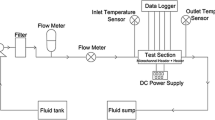Abstract
The present study investigates the microchannel heat sink for pure electroosmotic, pressure-driven, and mixed (electroosmotic and pressure-driven) flows. A three-dimensional numerical analysis is performed for electroosmotic and mixed flows. Electroosmotic flow (EOF) induced in an ionic solution in the presence of surface charge and electric field is investigated with hydrodynamic pressure-driven flow (PDF) to enhance heat removal through the microchannel heat sink. In a pressure-driven microchannel heat sink, the application of an external electric field increases the flow rate that consequently reduces the thermal resistance. The effects of ionic concentration represented by the zeta potential and Debye thickness are studied with the various steps of externally applied electric potential. A higher value of zeta potential leads to higher flow rate and lower thermal resistance, which consequently reduce the temperature of the microprocessor chip and load of the micropump used to supply coolant to the microchannels.
Similar content being viewed by others
References
D. B. Tuckerman and R. F. W. Pease, High-performance heat sinking for VLSI, IEEE Electron device Lett., EDL-2(5) (1981) 126–129.
Y. Yener, S. Kakac, M. Avelino and T. Okutucu, Single-phase forced convection in microchannels: A State-of-the-Art Review, In: S. Kakac, L. L. Vasiliev, Y. Bayazitoglu, and Y. Yener (ed), Microscale Heat Transfer, Springer, Neatherlands, 2005.
W. Qu and I. Mudawar, Analysis of three dimensional heat transfer in micro-channel heat sinks, International Journal of Heat and Mass Transfer, 45(19) (2002) 3973–3985.
K. C. Toh, X. Y. Chen and J. C. Chai, Numerical computation of fluid flow and heat transfer in microchannels, International Journal of Heat and Mass Transfer, 45 (2002) 5133–5141.
Z. Li, X. Huai, Y. Tao and H. Chen, Effects of thermal property variations on the liquid flow and heat transfer in microchannel heat sinks, Applied Thermal Engineering, 27 (2007) 2803–2814.
Y. Joshi and X. Wei, Micro and meso scale compact heat exchangers in electronics thermal management-A review, In: R. K. Shah, M. Ishizuka, T. M. Rudy, and V. V. Wadekar (ed), Proceedings of fifth international conference on Enhanced, Compact and Ultra-Compact Heat Exchangers: Science, Engineering and Technology, Engineering Conferences International, Hoboken, NJ, USA, (2005).
D. J. Laser and J. G. Santiago, A review of micropumps, Journal of Micromechanics and Microengineering, 14 (2004) R35–R64.
G. M. Mala, D. Li, C. Werner, H.-J. Jacobasch and Y. B. Ning, Flow characteristics of water through a microchannel between two parallel plates with electrokinetic effects, International Journal of Heat and Fluid Flow, 18 (1997) 489–496.
C. Yang, D. Li and J. H. Masliyah, Modeling forced liquid convection in rectangular microchannels with electrokinetic effects, International Journal of Heat and Mass Transfer, 41 (1998) 4229–4249.
S. Arulanandam and D. Li, Liquid transport in rectangular microchannels by electroosmotic pumping, Coll Surf-A: Physicochemical Engineering Aspects, 161 (2000) 89–102.
L. Jiang, J. Mikkelsen, J.-M. Koo, D. Huber, S. Yao, L. Zhang, P. Zhou, J. G. Maveety, R. Prasher, J. G. Santiago, T. W. Kenny and K. E. Goodson, Closed-Loop electroosmotic microchannel cooling system for VLSI circuits, IEEE Transactions on Components and Packaging Technologies, 25(3) (2002) 347–355.
N. A. Patankar and H. H. Hu, Numerical simulation of electroosmotic flow, Anal. Chem, 70 (1998) 1870–1881.
G. L. Morini, M. Lorenzini, S. Salvigni and M. Spiga, Thermal performance of silicon micro heat-sinks with electrokinetically-driven flows, International Journal of Thermal Science, 45 (2006) 955–961.
P. Dutta, K. Horiuchi and H.-M. Yin, Thermal characteristics of mixed electroosmotic and pressure-driven microflows, Comp. Math. Appli., 52 (2006) 651–670.
A. Jain and M. K. Jensen, Analytical modeling of electrokinetic effects on flow and heat transfer in microchannels, International Journal of Heat and Mass Transfer, 50 (2007) 5161–5167.
G. Tang, D. Yan, C. Yang, H. Gong, C. Chai and Y. Lam, Joule heating and its effects on electrokinetic transport of solutes in rectangular microchannels, Sensors and Actuators A, 139 (2007) 221–232.
A. J. Bard and L. R. Faulkner, Electrochemical methods: Fundamentals and applications, Wiley, New York, USA, (1980).
CFD-ACE+, Software manuals, CFD Research Corporation, (2007).
J. P. Van Doormaal and G. D. Raithby, Enhancements of the SIMPLE method for predicting incompressible fluid flows, Numerical Heat Transfer, 7 (1984) 147–163.
D. Liu and S. V. Garimella, Analysis and optimization of the thermal performance of microchannel heat sinks, International Journal for numerical methods in Heat and Fluid flow, 15(1) (2005) 7–26.
F. P. Incropera and D. P. DeWitt, Fundamentals of heat and mass transfer, John Wiley & Sons Inc, New York, USA, (2002).
R. F. Probstein, Physicochemical hydrodynamics, Wiley and Sons Inc, New York. USA, (1994).
Author information
Authors and Affiliations
Corresponding author
Additional information
This paper was recommended for publication in revised form by Associate Editor Do Hyung Lee
Afzal Husain received B.E. and M.Tech. degrees in Mechanical Engineering with specialization in Thermal Sciences from Aligarh Muslim University, India in 2003 and 2005, respectively. Currently he is pursuing Ph.D. degree in Thermodynamics and Fluid Mechanics in Inha University, Republic of Korea. His research interests are numerical analysis and optimization of heat transfer systems using computational fluid dynamics and surrogate models, development of heat transfer augmentation techniques for conventional and micro systems, thermal analysis of microelectromechanical systems (MEMS), and electronic cooling.
Kwang-Yong Kim received a B.S. degree from Seoul National University in 1978, and his M.S. and Ph.D. degrees from Korea Advanced Institute of Science and Technology (KAIST), Korea, in 1981 and 1987, respectively. Presently, he is professor and chairman, School of Mechanical Engineering, Inha University, Incheon, Korea. Prof. Kim is presently the editor-in-chief of Transactions of Korean Society of Mechanical Engineers (KSME), the editor-in-chief of International Journal of Fluid Machinery and Systems (IJFMS), and chief vice president of Korean Fluid Machinery Association (KFMA). Prof. Kim is Fellow of American Society of Mechanical Engineers (ASME).
Rights and permissions
About this article
Cite this article
Husain, A., Kim, KY. Electroosmotically enhanced microchannel heat sinks. J Mech Sci Technol 23, 814–822 (2009). https://doi.org/10.1007/s12206-009-0206-x
Received:
Revised:
Accepted:
Published:
Issue Date:
DOI: https://doi.org/10.1007/s12206-009-0206-x




